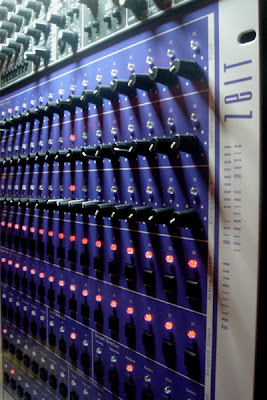 Click here
Click here for additional shots pulled via
this auction.
via
loschaDetails:
"4 x 112 Dual VCO Modules
This module consists of two independent Voltage control Oscillators. A variety of external controls are possible with this unit including, Pulse Width Modulation and strong and weak sync mode for phase locking. Simultaneous Manual Pulse Width Modulation is also possible. Each VCO has five different range settings from 32' to 2' as well as a Tuning control. Three different waveforms are available on each including, Triangle, Sawtooth, and pulse.
3 x 121 Dual VCF Modules
Two independent VCF's are part of this package. Each VCF includes the added feature of a built-in foxed high pass filter with a switch for turning the high pass functio off or selecting one of three cutoff points. Each VCF also includes three audio and three control inputs, and LED's for following signal flow. The green LED's light when a signal appears at the outputs, the red LED's light for overdrive (distort) condition.
4 x 140 Dual Envelope Generators & LFO
The 140-module and the 110 module provide the minimum basic elements necessary to produce a single synthesizer voice. Two voices can be provided with the added use of modules 112,121, and 130. ADSR's can be triggered from the keyboard's gate or gate + trigger, from an external gate, or manually with the front panel pushbutton. Both envelope generators provide inverted and normal outputs. Voltage controlled low frequency oscillator (LFO) has a built-in delay for delayed vibrato effects. KYBD TRIG switch allows phase locking of LFO output to keyboard trigger pulse.
6 x 130 Dual VCA
Two independent Voltage Control Amplifiers are included in this single package. Each VCA provides three audio inputs with continually variable level controls. Three VCA Modulation inputs are also included, each having its own level control. The outputs of each VCA have a low and high output jack with LED's to monitor output levels. An initial gain control that is continuously variable is included on each VCA and the user is allowed to choose between an exponential or linear response.
2 x 150 Ring Mod, Lfo and S&H
The most common function of the ring modulator is to combine two VCO outputs to produce metallic, bell clanging sounds. The Sample and Hold can be used for sampling an input waveform or for producing control voltage patterns based on that waveform. The musical result is patterns of notes such as arpeggios, random notes, etc.
3 x 132 Signal Mixer and Voltage Processors
Each mixer is a four-channel mixer with simultaneous inverted and non-inverted outputs. They can be used for summing control voltages and/or for mixing audio signals. Both include built-in posititve and negative voltage sources. A red LED indicates an overload condition. The module also includes a separate variable negative voltage source.
2 x 131 4 Channel Stereo Output Mixer
This four-channel stereo mixer has panning on each channel. The mixer can be ised in four track recording or to coordinate multiple synthesizer outputs. Also included are a stereo headphone output with separate level control: 220Hz, 440Hz, 880Hz. Mixer program outputs include left and right stereo outputs and separate mono output. Program outputs include both mini-jacks and 1/4" phone jacks for convenient connection to other parts of the synthesizer or to other studio equipment- Each program output also includes a red LED to show overload (distortion) condition.
1 x 165 Dual Portamento
Two independent portamento controllers are included in one module. Because the portamento time can be controlled by an external control voltage, you can be more expressive in the musical melody.
1 x 172 Phase Shifter and Effects Unit
The phase shifter and audio delay can be used for producing spatial effects. Both include convenient effect on/off switches and can be controlled from an external control voltage source so that two units may be used together for stereo effects, or may be used as a part of the sound synthesis process itself. The built-in control LFO has both normal and inverted outputs. The gate delay can be used where desirable to provide a delayed output from a pulse source, or it can be used as a pulse shaper. The gate delay also has a built-in high gain amplifier with a THRESHOLD control so that low level pulses recorded on tape can be amplified and shaped into a form which will trigger synthesizer functions.
1 x 174 Parametric EQ
This module has a four-band parametric equalizer. Each center frequency can be set exactly within the range of 20Hz to 20kHz, using four control knobs with overlapping effective ranges. Each frequency level can be set individually within the range of =,9 to 9. As an equalizer this module can be used to create various tone colours, and as an effector by exaggerating the setting of each parameter.
8 VCO's, 6 VCF's, 8 EG, 7 LFO, 12 VCA,
5 Mixers and the 'rare' modules - dual portamento, effects and parametric
add up to a MONSTER MODULAR"
 via Brandon.
via Brandon.


 Update: Adding a shot from this previous post on what this could look like. The shot is an Elby Designs Steiner VCF via cray5656's flickr set.
Update: Adding a shot from this previous post on what this could look like. The shot is an Elby Designs Steiner VCF via cray5656's flickr set. Title link takes you to shots pulled via this auction.
Title link takes you to shots pulled via this auction.











